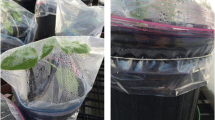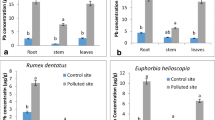Abstract
Heavy metals are environmental contaminants that have gained much attention globally. Plant growth and development are greatly affected by toxic heavy metals like lead, copper, and chromium. Cosmos sulphureus Cav. an ornamental plant was grown in hydroponics system against these metals. Plants were exposed to 2, 4, and 8 mg L−1 lead; 5, 10, and 15 mg L−1 copper, and 2.5, 5, and 10 mg L−1 chromium for 3 weeks using control as reference. Lead stress slightly affected the growth of C. sulphureus, however, had extreme signs of phytotoxicity due to copper and chromium. At 8 mg L−1 lead, reductions by 21, 25, 45, and 38% in fresh and dry weight, shoot, and root length were observed, respectively, as compared to control while reductions due to copper/chromium (15/10 mg L−1 in hydroponics) were 79/77, 90/73, 56/60, and 87/90%, respectively. Lead accumulated mostly in roots of C. sulphureus and was observed to be 1000 mg kg−1 at 8 mg L−1. While copper and chromium were also accumulated mainly in roots and were 3 mg kg−1 and 900 mg kg−1, respectively, at 10 mg L−1 in external solution. C. sulphureus without lead-induced phytotoxic effects as well as higher accumulation in roots, strongly advocates this plant as a potential candidate of lead-hyperaccumulator; however, further investigations at the physiological and molecular level are needed to explore the mechanisms for lead homeostasis in roots.
Graphic abstract





Similar content being viewed by others
References
Ali NA, Ater M, Sunahara GI, Robidoux PY (2004) Phytotoxicity and bioaccumulation of copper and chromium using Barley (Hordeum vulgare L.) in spiked artificial and natural forest soils. Ecotoxicol Environ Saf 57:363–374
Alirzayeva E, Neumann G, Horst W, Allahverdiyeva Y, Specht A, Alizade V (2017) Multiple mechanisms of heavy metal tolerance are differentially expressed in ecotypes of Artemisia fragrans. Environ Pollut 220:1024–1035
Arshad M, Khan AHA, Hussain I, Anees M, Iqbal M, Soja G, Linde C, Yousaf S (2017) The reduction of chromium (VI) phytotoxicity and phytoavailability to wheat (Triticum aestivum L.) using biochar and bacteria. Appl Soil Ecol 114:90–98
Ashraf S, Ali Q, Zahir ZA, Ashraf S, Asghar HN (2019) Phytoremediation: environmentally sustainable way for reclamation of heavy metal polluted soils. Ecotoxicol Environ Saf 174:714–727
Borkert C, Cox F, Tucker M (1998) Zinc and copper toxicity in peanut, soybean, rice, and corn in soil mixtures. Commun Soil Sci Plan 29:2991–3005
Chaney RL, Baklanov IA (2017) Phytoremediation and phytomining: status and promise. Adv Bot Res 83:189–221
Daud M, Mei L, Variath M, Ali S, Li C, Rafiq M, Zhu S (2014) Chromium (VI) uptake and tolerance potential in cotton cultivars: effect on their root physiology, ultramorphology, and oxidative metabolism. BioMed Res Int 2014, Article ID 975946
Eun SO, Shik Youn H, Lee Y (2000) Lead disturbs microtubule organization in the root meristem of Zea mays. Physiol Plant 110:357–365
Gupta DK, Nicoloso FT, Schetinger MRC, Rossato LV, Pereira LB, Castro GY, Srivastava S, Tripathi RD (2009) Antioxidant defence mechanism in hydroponically grown Zea mays seedlings under moderate lead stress. J Hazard Mater 172(1):479–484
Gupta DK, Huang HG, Yang XE, Razafindrabe BHN, Inouhe M (2010) The detoxification of lead in Sedum alfredii H. is not related to phytochelatins but the glutathione. J Hazard Mater 177:437–444
He B, Gu M, Wang X, He X (2018) The effects of lead on photosynthetic performance of waxberry seedlings (Myrica rubra). Photosynthetica 56:1147–1153
Jeevanantham S, Saravanan A, Hemavathy RV, Kumar PS, Yaashikaa PR, Yuvaraj D (2019) Removal of toxic pollutants from water environment by phytoremediation: a survey on application and future prospects. Environ Technol Inno 13:264–276
Kaur G, Singh HP, Batish DR, Kohli RK (2013) Lead (Pb)-induced biochemical and ultrastructural changes in wheat (Triticum aestivum) roots. Protoplasma 250:53–62
Khan Z, Doty S (2011) Endophyte-assisted phytoremediation. Plant Biol 12:97–105
Khan A, Khan S, Alam M, Khan MA, Aamir M, Qamar Z, Rehman ZU, Perveen S (2016) Toxic metal interactions affect the bioaccumulation and dietary intake of macro-and micro-nutrients. Chemosphere 146:121–128
Khan AHA, Butt TA, Mirza CR, Yousaf S, Nawaz I, Iqbal M (2019a) Combined application of selected heavy metals and EDTA reduced the growth of Petunia hybrida L. Sci Rep 9:4138
Khan AHA, Nawaz I, Yousaf S, Cheema AS, Iqbal M (2019b) Soil amendments enhanced the growth of Nicotiana alata L. and Petunia hydrida L. by stabilizing heavy metals from wastewater. J Environ Manage 242:46–55
Khan AHA, Kiyani A, Cheema AS, Tareen U, Nawaz I, Iqbal M, Yousaf S (2020) Integrative application of soil conditioners and bio-augmentation for enhanced heavy metal stabilization from wastewater and improved growth of Nicotiana alata L. and Petunia hydrida L. J Plant Growth Regul 1–14
Liu J, Xin X, Zhou Q (2017) Phytoremediation of contaminated soils using ornamental plants. Environ Rev 26:43–54
Malecka A, Piechalak A, Tomaszewska B (2009) Reactive oxygen species production and antioxidative defense system in pea root tissues treated with lead ions: the whole roots level. Acta Physiol Plant 31:1053–1063
Mallick S, Sinam G, Mishra RK, Sinha S (2010) Interactive effects of Cr and Fe treatments on plants growth, nutrition and oxidative status in Zea mays L. Ecotoxicol Environ Saf 73:987–995
Meyers DE, Auchterlonie GJ, Webb RI, Wood B (2008) Uptake and localization of lead in the root system of Brassica juncea. Environ Pollut 153:323–332
Nie JY, Kuang LX, Li ZX, Xu WH, Wang C, Chen QS, Li A, Zhao XB, Xie HZ, Zhao DY (2016) Assessing the concentration and potential health risk of heavy metals in China’s main deciduous fruits. J Integr Agric 15:1645–1655
Novo LA, Castro PM, Alvarenga P, Da Silva EF (2018) Plant growth-promoting rhizobacteria-assisted phytoremediation of mine soils. Bio-Geotechnologies for Mine Site Rehabilitation. Elsevier; pp 281–295
Ojuederia O, Babalola O (2017) Microbial and plant-assisted bioremediation of heavy metal polluted environments: a review. Int J Environ Res Public Health 14:1504
Piwowarczyk B, Tokarz K, Muszyńska E, Makowski W, Jędrzejczyk R, Gajewski Z, Hanus-Fajerska E (2018) The acclimatization strategies of kidney vetch (Anthyllis vulneraria L,) to Pb toxicity. Environ Sci Pollut Res 25:19739–19752
Prasad MNV, Greger M, Landberg T (2001) Acacia nilotica L. bark removes toxic elements from solution: corroboration from toxicity bioassay using Salix viminalis L. in hydroponic system. Int J Phytoremed 3:289–300
Qing X, Zhao X, Hu C, Wang P, Zhang Y, Zhang X, Wang P, Shi H, Jia F, Qu C (2015) Selenium alleviates chromium toxicity by preventing oxidative stress in cabbage (Brassica campestris L. ssp. Pekinensis) leaves. Ecotoxicol Environ Saf 114:179–189
Radziemska M, Gusiatin Z, Bilgin A (2017) Potential of using immobilizing agents in aided phytostabilization on simulated contamination of soil with lead. Eco Eng 102:490–500
Raza A, Khan AHA, Nawaz I, Qu Z, Yousaf S, Ali MA, Sayal AU, Iqbal M (2019) Evaluation of arsenic-induced stress in Dahlia pinnata Cav: morphological and physiological response. Soil Sedim Contam Int J 28:716–728
Rodriguez E, Azevedo R, Fernandes P, Santos CAO (2011) Cr(VI) induces DNA damage, cell cycle arrest and polyploidization: a flow cytometric and comet assay study in Pisum sativum. Chem Res Toxicol 24:1040–1047
Rungruang N, Babel S, Parkpian P (2011) Screening of potential hyperaccumulator for cadmium from contaminated soil. Desalin Water Treat 32:19–26
Samantary S (2002) Biochemical responses of Cr-tolerant and Cr-sensitive mung bean cultivars grown on varying levels of chromium. Chemosphere 47:1065–1072
Samardakiewicz S, Woźny A (2005) Cell division in Lemna minor roots treated with lead. Aquat Bot 83:289–295
Saravanan A, Jeevanantham S, Narayanan VA, Kumar PS, Yaashikaa PR, Muthu CM (2020) Rhizoremediation-A promising tool for the removal of soil contaminants: a review. J Environ Chem Eng 8:103543
Shanker AK, Djanaguiraman M, Venkateswarlu B (2009) Chromium interactions in plants: current status and future strategies. Metallomics 1:375–383
Sharma P, Dubey RS (2005) Lead toxicity in plants. Braz J Plant Physiol 17:35–52
Singh HP, Mahajan P, Kaur S, Batish DR, Kohli RK (2013) Chromium toxicity and tolerance in plants. Environ Chem Lett 11:229–254
Sricoth T, Meeinkuirt W, Saengwilai P, Pichtel J, Taeprayoon P (2018) Aquatic plants for phytostabilization of cadmium and zinc in hydroponic experiments. Environ Sci Pollut Res 25:14964–14976
Sudiarto SIA, Renggaman A, Choi HL (2019) Floating aquatic plants for total nitrogen and phosphorus removal from treated swine wastewater and their biomass characteristics. J Environ Manage 231:763–769
Sundaramoorthy P, Chidambaram A, Ganesh KS, Unnikannan P, Baskaran L (2010) Chromium stress in paddy: (i) nutrient status of paddy under chromium stress; (ii) phytoremediation of chromium by aquatic and terrestrial weeds. C R Biol 33:597–607
Warne MSJ, Heemsbergen D, Stevens D, McLaughlin M, Cozens G, Whatmuff M, Broos K, Barry Bell M, Nash D (2008) Modeling the toxicity of copper and zinc salts to wheat in 14 soils. Environ Toxicol Chem 27:786–792
Wu M, Luo Q, Liu S, Zhao Y, Long Y, Pan Y (2018) Screening ornamental plants to identify potential Cd hyperaccumulators for bioremediation. Ecotoxicol Environ Saf 162:35–41
Yaashikaa PR, Senthil KP, Varjani S, Saravanan A (2020) Rhizoremediation of Cu(II) ions from contaminated soil using plant growth promoting bacteria: an outlook on pyrolysis conditions on plant residues for methylene orange dye biosorption. Bioengineered 11:175–187
Yruela I (2005) Copper in plants. Braz J Plant Physiol 17:145–156
Zhou XQ, Li YH (2004) The physiological and ecological responses of the seed germination of Casuarina equisetifolia to chromic stress. Chin J Eco Agric 12:53–55
Zhou G, Guo J, Yang J, Yang J (2018) Effect of fertilizers on Cd accumulation and subcellular distribution of two cosmos species (Cosmos sulphureus and Cosmos bipinnata). Int J Phytoremediat 20:930–938
Acknowledgements
This research has been funded by Scientific Research Deanship at University of Ha’il, Saudi Arabia through project number RG-20082.
Author information
Authors and Affiliations
Corresponding author
Ethics declarations
Conflict of interest
The authors declare no conflict of interests.
Ethical approval
This article does not contain any studies with human participants or animals performed by any of the authors.
Additional information
Editorial responsibility: Senthil Kumar Ponnusamy.
Electronic supplementary material
Below is the link to the electronic supplementary material.
Rights and permissions
About this article
Cite this article
Aftab, N., Saleem, K., Khan, A.H.A. et al. Cosmos sulphureus Cav. is more tolerant to lead than copper and chromium in hydroponics system. Int. J. Environ. Sci. Technol. 18, 2325–2334 (2021). https://doi.org/10.1007/s13762-020-02981-w
Received:
Revised:
Accepted:
Published:
Issue Date:
DOI: https://doi.org/10.1007/s13762-020-02981-w




